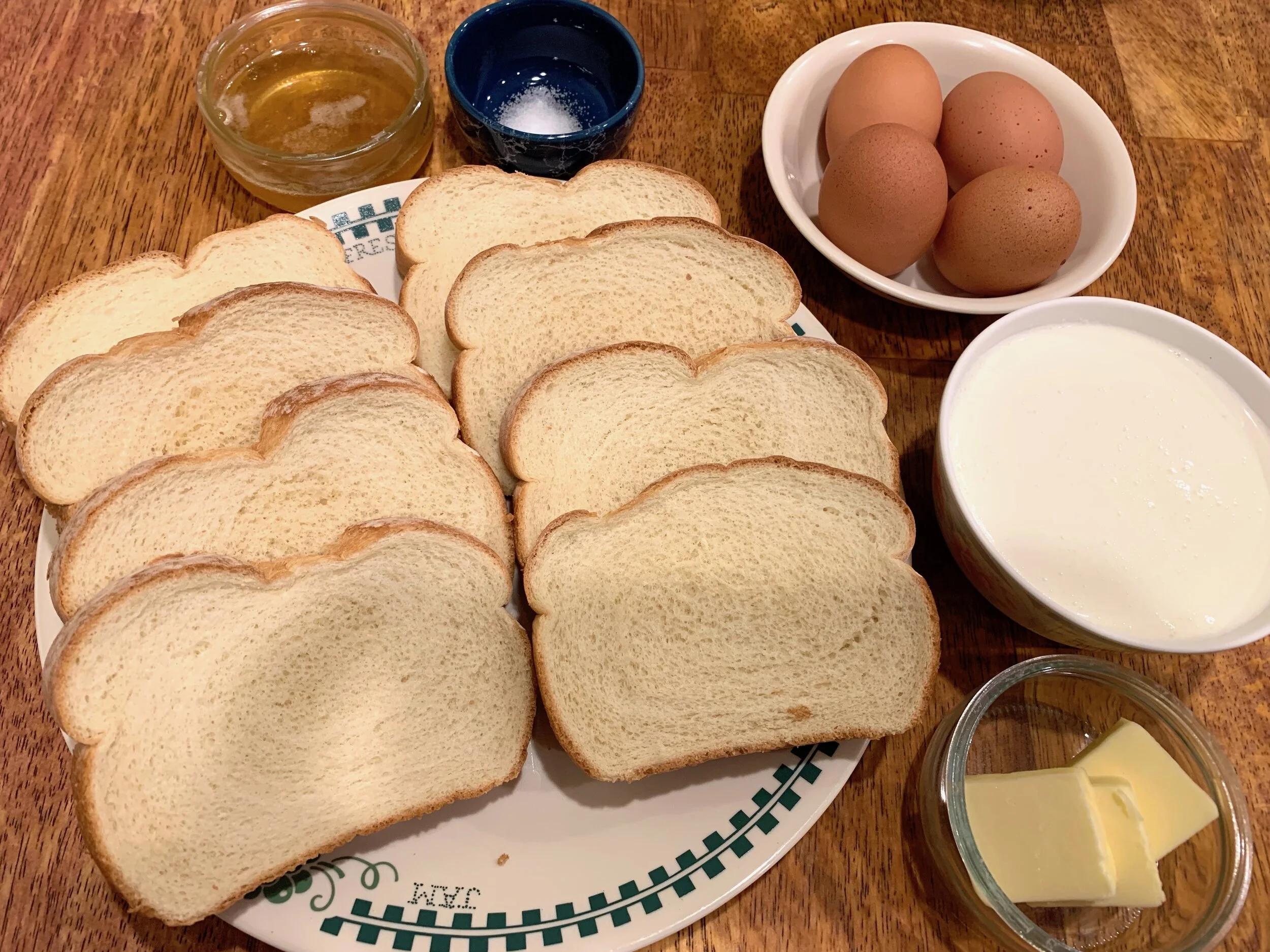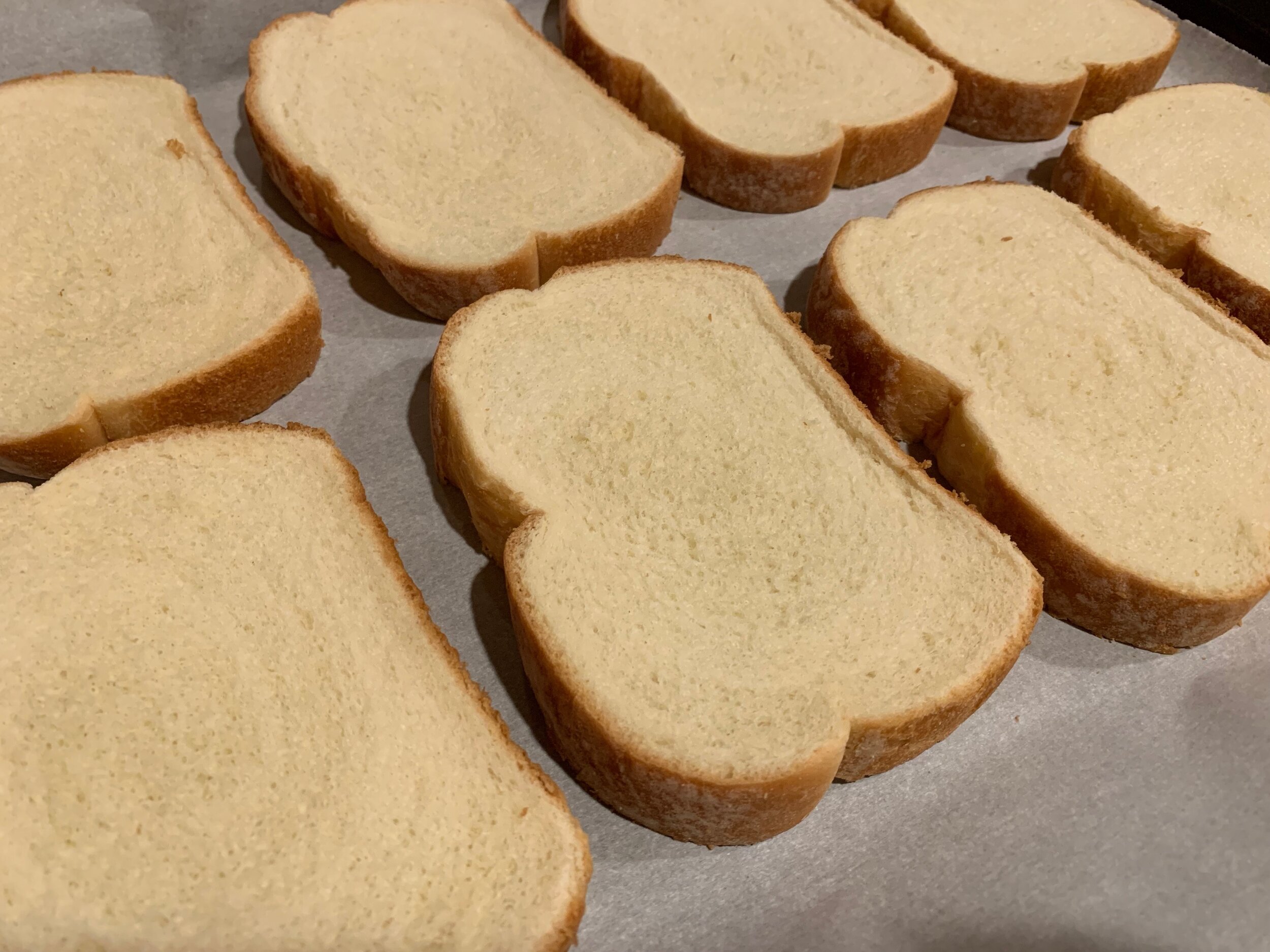French Toast

Pain Perdu
Perhaps initially a creative use for stale bread [1], French toast—slices of bread soaked in eggs and dairy and then fried—is a popular breakfast dish which goes by many names. In France, it is known as pain perdu, or “lost bread.” In Germany, it is known as arme ritter, or “poor knights.” While most commonly associated with French cuisine today, its proliferation throughout Europe suggests an older origin. Indeed, the earliest reference to a dish recognizable to us today as French toast can be found in the Apicius manuscript [2]: “Slice fine white bread, crust removed, into rather large pieces which soak in milk and beaten eggs. Fry in oil, cover with honey and serve.”
This good idea took off, and recipes for bread, soaked in milk and eggs and then fried, appear throughout Europe in medieval and Renaissance cookbooks, including examples in Italy, Germany, Spain, France, England, and Ireland. The term “French toast” is first recorded in an English cookbook dating to 1660. However, it was far from the only term used to describe this dish in the English language. Up until the late 1800s, French toast was being described alternately in English as “poor knights of Windsor,” “egg toast,” “Spanish toast,” “German toast,” and even “American toast.” However, perhaps because it proved the most marketable of all of these names, “French toast” endured.
Today, the dish is most commonly found in America. The ubiquity of the dish on breakfast and brunch menus in the United States is due in no small part to the presence of French toast on the menus of the great transcontinental trains which thundered across the American West from the late 1800s through to the middle of the 20th century. The flagship trains of the competing rail networks each advertised luxurious rides, where passengers would be treated to comfortable beds, awe-inspiring views, and gourmet food.
A Great Northern EMD F7 pulls the Empire Builder through Marias Pass in the Rocky Mountains, 1958. The dining cars of transcontinental and long-distance trains such as the Empire Builder did much to popularize French toast in America as an upscale breakfast dish. Other dishes made popular by American trains include chicken cordon bleu and shoo-fly pie.
The emphasis on good food put enormous pressure on the chefs and cooks of the railways, who had to prepare restaurant-quality food in a cramped and unstable rolling kitchen. These chefs soon converged on French toast as an ideal breakfast item—easy to make en masse, robust to the small mistakes inevitable in a kitchen on the move, and novel enough at the time to be considered luxurious.[3] In turn, French toast gained a reputation as a breakfast food of the well-to-do, a reputation the dish has carried into the restaurants and cafes of today.
French toast is a dish that has changed remarkably little over the years. One can imagine eating pretty much the same thing in an Ancient Roman villa, dreary Plantagenet castle, or a Pullman dining car. The version we will make today is not far at all from that recorded in the Apicius manuscript nearly two millennia ago.
Ingredients
8 slices bread (brioche, challah, or potato bread)
4 eggs
1 cup half-and-half
2 tbsp honey
¼ tsp salt
2 tbsp butter
French toast can be made out of most sorts of bread, and if you are making French toast out of leftover stale bread, by all means use whatever you have on hand. However, if you are buying bread specifically for French toast, we want a bread which is sturdy enough to absorb the custard without falling apart, but not so crusty that it is tough even after frying. Enriched breads which contain egg or dairy also tend to work well for French toast, as they tend to be slightly sweeter than regular breads, and have a denser crumb.
In my personal opinion, the best bread to use for French toast is brioche, with challah a close second. A surprise contender rounds out the podium places—potato bread has a denser texture than its white bread counterparts, and the slight potato flavor works surprisingly well with the custard. French bread is my choice for best-of-the-rest—if you’re using French bread, soak it in the custard for slightly longer than you would for the other breads.
French toast works best with slightly stale bread, so if you have the time, cut your bread into ¾ inch slices the night before. Set your slices of bread out on a tray, and let the bread stale overnight. The drier bread will be better able to soak up the custard the next morning!
When you are ready to start cooking, make the custard mixture by beating together the 4 eggs, half-and-half, honey, and salt. Use a dish wide enough to hold two pieces of bread—a pie dish works well for this. If you are using a bread you know to be on the saltier side, cut back on the salt in the custard.
Lay the slices of bread into the custard dish in a single layer, and soak the bread in the custard for 30 seconds per side, working in batches as necessary. Remove the soaked bread from the custard and let rest on a plate or wire rack for 2 minutes before frying. This resting period allows the liquid to move from the surface into the middle of the slice of bread, giving us a soft and creamy center when cooked.
Now let’s talk frying. We want the toast to be crisp on the outside, and to be fully cooked, yet still soft and creamy on the inside. The best way to accomplish both of these aims is to fry the toast at a relatively low heat, allowing the surface to brown gradually and preventing the edges of the bread from overcooking before the middle is fully cooked.
Heat 1 tablespoon of better in a nonstick pan over medium-low heat. When the butter is melted and the pan is hot, add the soaked bread slices to the pan in a single layer, working in batches as necessary. Fry the toast on the its first side for 3 minutes, without moving the bread. Then flip the toast and fry for 3 minutes on the second side. Once both sides have been cooked, remove the toast from the pan and repeat for the remaining bread slices, adding more butter as necessary.
French toast is best served as soon as possible, as the delicate crispness of the surface will deteriorate rapidly. There are a myriad of topping options, so go with your favorites—popular toppings include maple syrup, whipped cream, powdered sugar, and fruit.
Substitutions
For a richer custard, replace the half-and-half with an equal amount of cream. To make cinnamon French toast, mix 1 or 2 teaspoons of cinnamon into the custard. You can also add a few drops of vanilla extract to the custard, and nutmeg also works well in this recipe. The honey can be substituted for maple syrup or golden syrup.
If you are making large batches of French toast, keep the toast warm in an oven on low heat.
[1] Despite its purportedly humble origins, the historically expensive ingredients of white bread and sugar or honey make French toast a decidedly middle-class dish. As the name “arme ritter” and the similar “poor knights of Windsor” suggest, the dish was likely associated not with the working poor of medieval and Renaissance Europe, but rather with the poorest of the ruling gentry.
[2] It is unclear who wrote or assembled the Apicius manuscript, but historians are fairly certain that it was not a man named Apicius. There was a minister during the reign of Emperor Tiberius, Marcus Cavius Apicius, who was well known for his luxurious tastes. As a result, the name “Apicius” had entered the Roman vernacular as a gourmet or glutton, similar to how we might use “Einstein” in modern vernacular English to refer to someone who we think is smart. After the fall of the Roman Empire, Latin written works in Western Europe were preserved in monasteries, the monks writing out the work anew once every generation. In the game of telephone that was medieval manuscript copying, this subtle reference was lost, and the work came to be attributed in many cases to a fictional man named Caelius Apicius, a mistake that gets perpetuated to this day in insufficiently researched food writing.
[3] While the golden age of train travel in the United States may be over, as of time of writing there are still six Amtrak trains which run with dining cars. All six serve “Amtrak Signature Railroad French Toast.”
Recipe
Prep Time: 5 min Cook Time: 15 min Total Time: 20 min
Difficulty: 1/5
Heat Sources: 1 burner
Equipment: pan
Servings: 4
Ingredients
8 slices bread (brioche, challah, or potato bread)
4 eggs
1 cup half-and-half
2 tbsp honey
¼ tsp salt
2 tbsp butter
Instructions
1. Cut your bread into ¾ in slices and let stale, overnight if possible.
2. In a wide dish, beat together the 4 eggs, half-and-half, honey, and salt to make the custard mixture.
3. Working in batches as required by the size of your pan, soak the bread in the custard for 30 seconds per side. Remove the soaked bread from the custard and let rest for 2 minutes before frying.
4. Heat 1 tbsp butter in a pan over medium-low heat. When the pan is hot, add the soaked bread slices to the pan in a single layer, and fry for 3-4 minutes. Flip the toast and fry for an additional 3 minutes.
5. Remove the toast from the pan and let rest for 5 minutes before serving. Meanwhile, repeat steps 2-4 for your remaining bread slices.
6. Serve warm, with maple syrup, powdered sugar, whipped cream, and/or fruit, to your taste.













